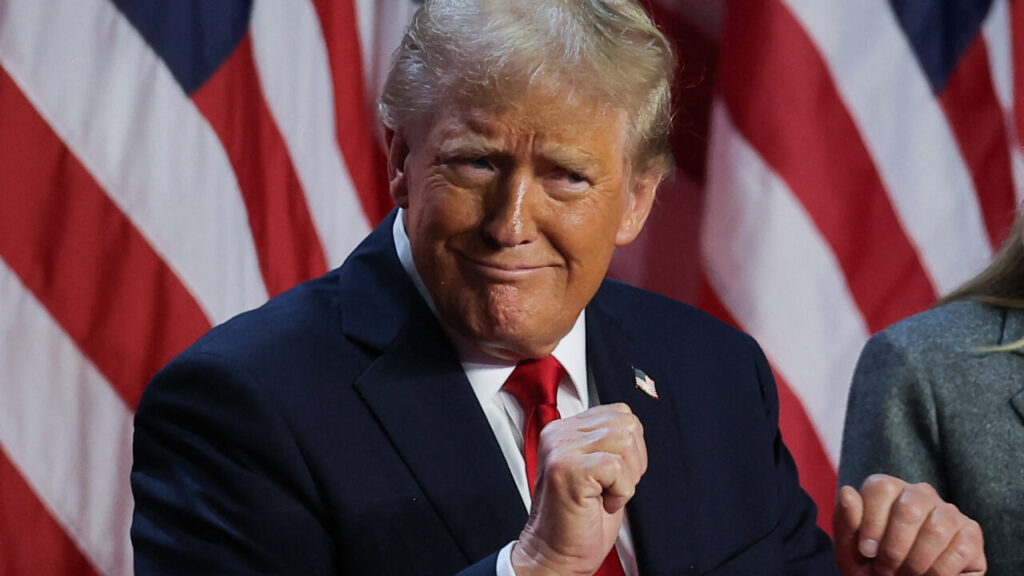Introduction to the Executive Order

On October 30, 2018, President Donald Trump announced a controversial executive order aimed at redefining birthright citizenship in the United States. The executive order sought to eliminate the longstanding interpretation of the 14th Amendment, which grants citizenship to all individuals born on U.S. soil. Trump’s announcement came amidst heightened discussions on immigration policy and legal frameworks governing citizenship, reflecting his administration’s broader hardline stance on immigration issues.
Thank you for reading this post, don't forget to subscribe!In the political context leading up to the issuance of this executive order, Trump consistently expressed his views on birthright citizenship, asserting that it encourages illegal immigration. He claimed that individuals crossing the U.S. border unlawfully can exploit this constitutional provision to secure citizenship for their children, thereby creating a loophole in the immigration system. This declaration was not merely a legal rebuttal but aligned with his campaign’s narrative, which sought to rally support among voters concerned about border security and immigration reform.
The executive order was positioned as a measure to restore the integrity of American citizenship, with the administration arguing that such a change would not only curb unauthorized immigration but also mitigate potential economic and social burdens attributed to illegal immigrants. Critics of the order, including constitutional scholars and immigration advocates, swiftly condemned this move, arguing that it would not hold up in court and could lead to significant legal challenges. Many believed that the president’s actions were less about substantive legal reform and more about generating political momentum ahead of the midterm elections.
This executive order thus served as a focal point in the wider national debate over immigration, showcasing the complexities of citizenship laws and the ideological divisions that characterize contemporary American politics.
Understanding Birthright Citizenship in the U.S.
Birthright citizenship in the United States is fundamentally rooted in the 14th Amendment to the U.S. Constitution, which was ratified in 1868. The pertinent clause, known as the Citizenship Clause, asserts that “all persons born or naturalized in the United States, and subject to the jurisdiction thereof, are citizens of the United States and of the State wherein they reside.” This legal provision was established primarily to grant citizenship to former slaves and their descendants following the Civil War, emphasizing the principle of equality under the law.
The historical significance of birthright citizenship cannot be overstated. It has functioned as a cornerstone of civil rights, ensuring that individuals born on American soil are citizens, irrespective of their parents’ immigration status. This provision seeks to eliminate any ambiguity regarding citizenship and fosters a sense of belonging and inclusion among diverse populations. Furthermore, it has shaped American society by allowing generations of families to establish their roots in the country, contributing to its cultural and economic landscape.
Over the decades, the concept of birthright citizenship has been both celebrated and scrutinized. Critics argue that the law may incentivize unauthorized immigration, positing that individuals may seek to enter the U.S. solely to secure citizenship for their children. However, advocates maintain that birthright citizenship upholds fundamental human rights and promotes equality, reflecting the values upon which the nation was founded. Additionally, legal precedent set by landmark Supreme Court decisions, including the case of United States v. Wong Kim Ark (1898), has reaffirmed the legitimacy of birthright citizenship, thereby reinforcing its role in American jurisprudence.
Thus, understanding birthright citizenship is vital to comprehending the broader implications of immigration policy and civil rights within the United States. This thorough examination of the 14th Amendment is essential for engaging with ongoing debates about citizenship and immigration reform in the contemporary political landscape.
Reactions from Legal Experts
The executive order issued by President Trump regarding birthright citizenship has sparked intense debate among legal scholars and constitutional experts. Many of these professionals argue that the order fundamentally contradicts established constitutional law, particularly the Fourteenth Amendment, which grants citizenship to anyone born on U.S. soil. This amendment has been interpreted for over a century to include children born to non-citizens, a principle widely recognized in American jurisprudence.
Professors of constitutional law have expressed grave concerns regarding the legality of the executive order. They argue that it attempts to unilaterally alter a long-standing interpretation of the Constitution, which could face significant hurdles in court. According to legal analysts, the prospect of challenges against the order is substantial, as many believe it could be deemed unconstitutional. Legal precedence holds that modifications to citizenship laws should only be enacted through congressional legislation rather than executive decrees, raising questions about the validity of such actions.
Furthermore, some experts underscore that the implications of the executive order extend beyond legality into ethical territory, raising matters of human rights and social justice. Legal scholars point out that should the order be enforced, it would likely lead to severe implications for families and children who have been born in the United States, igniting further debates about immigration policy and civil rights. As various interested parties contemplate the potential consequences of this executive action, attention will be closely focused on forthcoming legal challenges. The judiciary’s response to such challenges will be pivotal in determining the future of birthright citizenship in America, marking a crucial moment in the continual evolution of constitutional interpretation.
Political Reactions and Public Opinion
Following the announcement of President Trump’s executive order regarding birthright citizenship, a spectrum of political reactions and public opinions emerged, illustrating deep divisions within American society. Lawmakers and political figures from both sides of the aisle voiced their support or discontent with the implications of the order. Supporters hailed the move as a necessary step toward curbing illegal immigration and reaffirming national sovereignty. They argued that the interpretation of the Fourteenth Amendment’s citizenship clause had been historically misused and leveraged by undocumented immigrants to gain benefits in the United States. Prominent figures within the Republican Party argued that the executive order aligns with the administration’s broader goals of immigration reform and demonstrates a commitment to fulfilling campaign promises.
In stark contrast, critics of the executive order expressed significant concern regarding its legality and constitutional validity. Many Democratic lawmakers voiced their apprehensions, arguing that the order undermines a long-standing principle of American jurisprudence. They contended that birthright citizenship is rooted in the country’s foundational values and is critical for the protection of individual rights. Civil rights organizations joined the opposition, asserting that the policy disproportionately targets marginalized communities and could lead to further discrimination and social injustice.
The public’s response has also been varied, with polls reflecting a split opinion on the issue. Some segments of the populace supported the administration’s hardline stance on immigration, while others expressed outrage and called for resistance. Public protests and rallies were organized by advocacy groups, emphasizing the importance of inclusivity and equality in the American legal framework. The divergent reactions not only highlight the contentious nature of the executive order but also serve as a reflection of the broader political divisions currently shaping the national discourse. These discussions ultimately raise fundamental questions about the future of immigration policy in the United States.
Impact on Families and Children
The executive order regarding birthright citizenship, issued by President Trump, has potential ramifications that extend deeply into the lives of families and children born in the United States. This measure is predicated on the assertion that children born to undocumented immigrants should not automatically receive citizenship. As a result, families may find themselves facing a myriad of emotional and social challenges that can significantly impact their daily lives.
For children who may be born to parents without legal status in the U.S., the fear of being categorized as stateless looms large. Such a label can lead to issues surrounding their identity and belonging in a nation they have always known as home. The psychological burden this creates is considerable; children may struggle with feelings of insecurity and have concerns about their future, which can adversely affect their mental health. Additionally, the stigma associated with their parents’ immigration status can make them vulnerable to social ostracization and discrimination.
Access to critical services such as education, healthcare, and social programs may also be jeopardized by this executive order. Children, regardless of their citizenship status, benefit from institutional support that fosters growth and development. However, uncertainties surrounding their legal status can lead to parents refraining from seeking necessary services, fearing potential repercussions or deportation. This reluctance not only hampers the well-being of these children but also places undue strain on families that wish to provide a nurturing environment.
Moreover, the divisive nature of the discussion surrounding this executive order fosters an environment of fear and mistrust within communities. The emotional toll of living in such uncertainty affects family dynamics, as parents grapple with the challenges of protecting their children while navigating a complicated legal landscape. Ultimately, the implications of this executive order extend far beyond political rhetoric, directly influencing the fabric of families across the nation.
Implications for Immigration Policy
The executive order issued by President Trump targeting birthright citizenship represents a critical juncture in the trajectory of U.S. immigration policy. Traditionally, the policy was interpreted as granting citizenship to individuals born on American soil, an aspect enshrined in the 14th Amendment. However, this executive action seeks to challenge that long-standing interpretation, suggesting a potential shift in the policy landscape.
By pursuing this executive order, the Trump administration signals a pronounced intention to redefine key principles underpinning American immigration practices. This move could potentially influence the trajectories of future immigration reforms, shaping discussions around citizenship and immigration rights. Furthermore, the order raises essential questions about who qualifies for citizenship and what it means to be an American. Such shifting narratives could risk the stability established by previous administrations, igniting complex debates within legislative, legal, and social arenas.
Aligned with Trump’s broader agenda concerning immigrants and refugees, this executive order may reflect his administration’s dedication towards a more restrictive immigration policy. It underscores an inclination to prioritize a “merit-based” approach, suggesting a pivot away from foundations that have historically encouraged diversity. As the implications of this executive order unfold, it could catalyze significant legal challenges and provoke debates among policymakers, stakeholders, and the general public.
In summary, President Trump’s executive order on birthright citizenship carries substantial implications for the future of U.S. immigration policy. It may usher in a new era of restrictive measures, affecting not only birthright citizenship but the overall framework of immigration discussions in the United States. Understanding these implications is vital as they will likely shape the political and social discourse surrounding immigration for years to come.
Historical Context: Previous Executive Actions on Immigration
The issue of immigration and citizenship has a long-standing history in the United States, with various presidential administrations utilizing executive actions to shape policies. Notably, the power to influence immigration legislation is often exercised through executive orders, resulting in a series of controversial measures. Examining past executive actions reveals a pattern where presidents have sought to address immigration through unilateral directives, reflecting both political climates and societal attitudes towards the issue.
For instance, President Franklin D. Roosevelt implemented executive actions during World War II that affected the immigration status of certain populations, particularly Japanese Americans. This set a precedent for the use of executive authority to manage immigration and crises. Similarly, President Lyndon B. Johnson signed the Immigration and Nationality Act of 1965, which significantly altered the landscape of immigration policy, though more through legislation than executive orders. However, it did set an environment where future presidents would further rely on executive action during periods of legislative gridlock.

More contemporary actions include President Obama’s Deferred Action for Childhood Arrivals (DACA), established in 2012. This program aimed to protect undocumented immigrants brought to the U.S. as children from deportation, showcasing a powerful use of executive authority in immigration policy. DACA’s implementation sparked significant debate and legal challenges, highlighting the contentious nature of immigration reforms. Conversely, President Trump’s executive order concerning birthright citizenship brings present-day issues to light, reflecting themes of national identity and belonging that have been echoed throughout history.
- Mexico and Canada Reach Last-Minute Deal With Trump to Avert Trade War
- Panama agrees to end canal deal with China after Rubio visit
These historical examples underline the ongoing tension between executive power and immigration policy reform. As each administration navigates these waters, patterns emerge, revealing both continuity and change in how immigration is approached. Understanding these historical contexts provides insight into the complexities surrounding Trump’s executive order and its implications for the future of birthright citizenship in the United States.
Potential Legal Challenges Ahead
The recent executive order issued by President Trump concerning birthright citizenship has ignited a significant debate regarding its legality and implications. As a result, the anticipated legal challenges to this executive order are expected to emerge from various fronts, including civil rights organizations and numerous state entities. Given the contentious nature of the order, it is likely that numerous lawsuits will be filed—especially from groups that advocate for immigrant rights and those focused on safeguarding constitutional protections.
The judicial landscape surrounding these potential challenges is complex. Numerous cases related to immigration and citizenship rights have made their way through the courts in the past, providing a rich history of judicial interpretation. Courts have generally upheld the notion that the Fourteenth Amendment guarantees citizenship to all individuals born on U.S. soil, regardless of their parents’ immigration status. This historical precedent could strongly influence the arguments against the executive order, forming a foundation upon which many legal challengers may build their cases.
Moreover, civil rights organizations have already signaled their intent to fight against this directive, indicating that they may pursue legal action in federal courts. Such entities have historically played a crucial role in challenging governmental policies that they deem unconstitutional. It is also worth noting that various states may join these legal efforts, as state officials increasingly seek to protect the rights of citizens and residents within their jurisdictions.
Ultimately, the outcome of the anticipated legal challenges will hinge on the interpretation of constitutional law and the current composition of the judiciary. Observers are keenly monitoring this situation and awaiting decisions that could set significant precedents for the interpretation of citizenship rights in the United States. As the judicial processes unfold, the implications of this executive order will continue to be scrutinized by legal experts and the public alike.
Conclusion: The Future of Birthright Citizenship in America

The discussion surrounding President Trump’s controversial executive order on birthright citizenship has highlighted fundamental tensions within American society regarding citizenship and immigrant rights. Throughout this examination, we have explored the historical context of birthright citizenship, as established by the 14th Amendment, and how recent political actions have sought to challenge its applicability. This executive order signifies more than just a policy shift; it represents a broader ideological battle relating to the narratives of national identity and immigration in the United States.
As we analyze the potential future of birthright citizenship, several key points emerge. Firstly, the legal validity of the executive order is likely to be contested in courts, raising questions about the limits of presidential authority in matters traditionally managed by Congress. Legal scholars and lawmakers must consider whether altering long-standing interpretations of citizenship through an executive action is permissible, thus revealing divisions amongst legal authorities and political factions.
Secondly, this ongoing debate poses significant implications for immigrant communities, who are often left in uncertainty about their rights and status. Cultural and social factors, including public perception of immigration and citizenship, will continue to influence the landscape surrounding birthright citizenship. This environment not only shapes legislative discourse but also engenders grassroots movements focused on immigrant rights and the vital importance of a just immigration system.
In summary, as America delves into the consequences of the executive order on birthright citizenship, it will be essential to engage in meaningful discussions about the values and principles that define American citizenship. The future of birthright citizenship will undoubtedly be influenced by the evolving legal, social, and political landscapes, prompting society to grapple with fundamental questions about identity, belonging, and the meaning of citizenship in a diverse nation.



